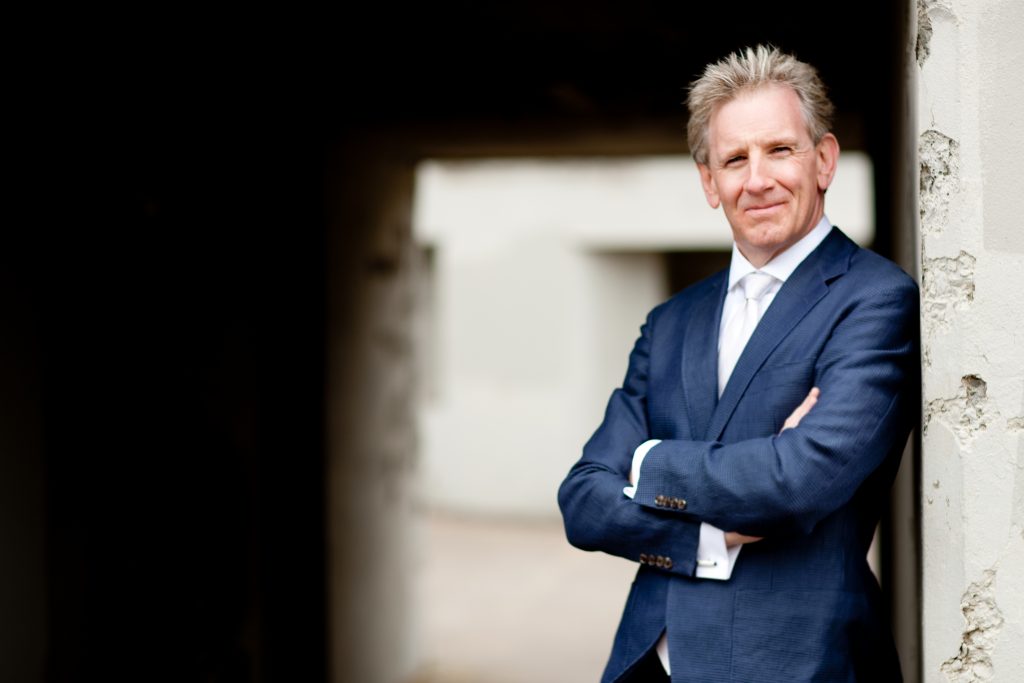
Conductor Michael Tilson Thomas’s creation, the New World Symphony, founded 29 years ago, is based in Miami Beach. It replaced Russia’s St. Petersburg Phiharmonic on Feb. 20 in the Kravis Center’s Regional Arts series.
Four concertos were programmed with soloists from the New World’s academy, which prepares players for leadership roles in major American orchestras. I was thrilled at the prospect of hearing four concertos from these talented youngsters, but frankly two is probably the maximum one needs, especially since this body of specially selected musicians plays the symphonic repertoire with such vigor and enthusiasm.
Alasdair Neale, music director of the Sun Valley Symphony and Marin Symphony (Calif.) was in charge. From 2001 to 2011, Neale was principal guest conductor of the New World.
The first soloist was tuba player Jarrett McCourt in Arild Plau’s Concerto for Tuba and String Orchestra. The tuba is a latecomer to the symphony, taking its place in the brass section in the mid-19th century. Despite its impressive range of pitches and dynamics, scomposers have been slow to write concertos for it. Ralph Vaughan Williams and Hollywood’s John Williams wrote concertos in 1954 and 1985, respectively.
Norwegian composer Arild Plau (1920-2005) wrote his concerto in 1990. Soft strings start in a low pastoral mood, then the tuba repeats it quietly. Quick scales follow from the soloist, stressing the flexibility of the instrument. Returning to the first theme, rushing strings declare a new melody, a catchy tune on which the tuba extemporizes at great length. Soloist and Tuba are as one, though only occasionally does one see McCourt’s head buried behind this giant piece of brass. His beautiful, even tone and almost breathless playing brought the Prolog movement to an end with four long held notes.
The second-movement Canzone, opens gently with the violins again, this time playing a remarkable beautiful melody as the tuba joins in softly. Later in the movement, it was a delight to hear McCourt bring out the variety of sounds up and down the instrument’s register. And in the finale, McCourt’s deft phrasing and articulation were showcased to great effect; strengths the tuba rarely gets to maximize in the symphonic repertoire.
Once recorded in 2003, this very pleasant concerto became a staple for tuba players around the world. I certainly hope tuba players in America get their chance to step out in front of their orchestras and have their 16 minutes — that’s its length — of fame. Jarrett McCourt, a second-year New World Fellow from Windsor, Ontario, with his lovely smooth intonation, made his tuba sound like a cornet.
Ernest Bloch’s Schelomo came next. The Swiss-born Bloch focused on expressing his Jewish identity in his music, and what magnificent music it is. “Schelomo” is the Hebrew name for Solomon, and Bloch tried for years to write music evoking King Solomon’s words in the Old Testament. Nothing satisfied him until he met cellist Alexander Barjansky. Hearing his cello, Bloch settled on that instrument to convey the power and wisdom of Solomon.
Cellist Thomas Carpenter (a second-year Fellow from Charlottesville, Va.) was the soloist for this work, which is full of beautiful, searching music that indeed does remind one of the mysteries of the Holy Land. Carpenter dug deep into his solo role, offering delicate reflection on music of lament and intense playing of the piece’s more assertive movements.
It is captivating music, and at the end, after the cello section accompanied Carpenter in one last lament, then closed the piece with two plucked notes, there was a long silence as the audience took in the enormity of the experience: We had heard the voice of Solomon, and no one wanted to break the music’s magic spell. Then conductor Neale lowered his baton, and the crowd roared its approval.
Franz Joseph Haydn’s Cello Concerto No. 2 in D major, of 1783, was anti-climatic following the Bloch piece. Hilary Glen, a third-year Fellow from Bloomington, Ind., gave a good account of this familiar work with reduced orchestra accompanying her. I was struck by the fine-tuned orchestral balance and her gentle approach to the difficult scales Haydn wrote for the cello.
Glen’s cadenza was beautifully played toward the end of the first movement. The discipline of the young New World players was remarkable; the freshness of their sound was like tasting a sweet dessert. In the final Allegro, Glen leds off with a skipping melody, bowing in time with the jumps in the music. This skipping tune is often repeated, as the soloist tackles a difficult passage sandwiched between lovely orchestral music. The refinement of soloist and orchestra in this joyful work came across beautifully.
Expectations were high for the final work, the Sibelius Violin Concerto, with South Korean soloist Ju Hyung Shin. A second-year Fellow, Shin has won numerous prizes in his homeland. By now I was sated by too many concertos in one program.
Neale, no doubt sensing this might be the case for the audience, brought out the very best playing from the orchestra, using Sibelius’s fantastic scoring to give an edge to what turned out to be a brilliant performance from soloist and orchestra.
In the first movement, Shin showed the depth of his commanding technique in the cadenza, and in the slow second movement, he was particularly effective in the lower register, making the most of Sibelius’s lovely themes. The rambunctious finale, with its hard-to-play main theme, was mastered easily by Shin, received a standing ovation after his last, brilliant upward scale.
It was a memorable performance, as indeed was the whole evening. The future of classical music in America is clearly in safe hands with young artists like these lending their talents to orchestras throughout the land.
Editor’s note: The posting of this review was delayed by technical difficulties.